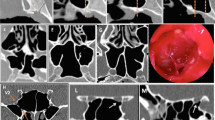Abstract
Purpose
The sphenoid ostium (SO) provides a natural portal for entering the sphenoid sinus and beyond up to the skull base. It is not always easy to locate the ostium during the endoscopic approach. The present study was designed to establish readily identifiable anatomical landmarks for locating the sphenoid ostium.
Methods
Cadaveric dissection was performed in 30 hemisections of head and neck and various measurements were taken from fixed anatomical landmarks in the nasal cavity to the sphenoid ostium. The size, shape and position of sphenoid ostium were determined in relation to the anterior wall of the sphenoid sinus and the superior turbinate.
Results
The mean distance from the supero-lateral angle of the posterior choana to the SO was found to be 21.21 ± 6.02 mm. The mean distance of the SO from the midline was 4.85 ± 2.89 mm. In all the specimens, the SO was situated within 1 cm of the midline. The mean distance between the inferior end of the SO and the postero-inferior edge of the superior turbinate was 8.03 ± 3.52 mm. The SO was present on an average distance of 55.1 ± 3.54 mm from the limen nasi. In 93.3 % of the specimens, the SO was situated between 5 and 6 cm of the inferior end of the limen nasi. The angle between the anterior nasal spine and the SO was found to be remarkably constant. In 93.3 % of the specimens, it was from 25° to 30°.
Conclusions
The sphenoid ostium could be localized medial to the superior turbinate between 1.5 and 3 cm above the supero-lateral angle of the posterior choana, within 1 cm of the midline and within 1 cm of the postero-inferior edge of the superior turbinate.





Similar content being viewed by others
References
Abuzayed B, Tanriöver N, Ozlen F, Gazioğlu N, Ulu MO, Kafadar AM, Eraslan B, Akar Z (2009) Endoscopic endonasal transsphenoidal approach to the sellar region: results of endoscopic dissection on 30 cadavers. Turk Neurosurg 19(3):237–244
Campero A, Emmerich J, Scolovsky M et al (2010) Microsurgical anatomy of the sphenoid ostia. J Clin Neurosci 17:1298–1300
Davis WE, Templer J, Parsons DS (1996) Anatomy of the paranasal sinuses. Otolaryngol Clin North Am 29:57–74
Elwany S, Yacout YM, Talaat M, EI-Nahass M, Gunied A, Talaat M (1983) Surgical anatomy of the sphenoid sinus. J Laryngol Otol 97:227–241
Enatsu K, Takasaki K, Kase K et al (2008) Surgical anatomy of the sphenoid sinus on the CT using multiplanar reconstruction technique. Otolaryngol Head Neck Surg 138:182–186
Eweiss AZ, Ibrahim AA, Khalil HS (2012) The safe gate to the posterior paranasal sinuses: reassessing the role of the superior turbinate. Eur Arch Otorhinolaryngol 269:1451–1456
Hidir Y, Battal B, Durmaz A et al (2011) Optimum height from the roof of the choana for seeking the sphenoid ostium. J Craniofac Surg 22:1077–1079
Hosemann WG, Weber RK, Keerl RE et al (2000) Minimally invasive endonasal sinus surgery. Principles, techniques, results, complications, revision surgery. Thieme, New York
Kim HU, Kim SS, Kang SS et al (2001) Surgical anatomy of the natural ostium of the sphenoid sinus. Laryngoscope 111:1599–1602
Lang J (1989) Clinical anatomy of the nose, nasal cavity and paranasal sinuses. Thieme Medical, New York
Levine HL (2004) Surgical approaches: endonasal endoscopic. In: Clemente MP, Levine HL (eds) Sinus surgery. Endoscopic and microscopic approaches. Thieme, New York, pp 154–156
Locatelli M, Caroli M, Pluderi M et al (2011) Endoscopic transsphenoidal optic nerve decompression: an anatomical study. Surg Radiol Anat 33(3):257–262
Millar DA, Orlandi RR (2006) The sphenoid sinus natural ostium is consistently medial to the superior turbinate. Am J Rhinol 20:180–181
Orhan M, Govsa F, Saylam C (2010) A quite rare condition: absence of sphenoidal sinuses. Surg Radiol Anat 32(6):551–553
Sethi DS, Leong JL (2006) Endoscopic pituitary surgery. Otolaryngol Clin North Am 39:563–583
Turgut S, Gumusalan Y, Arifoglu Y, Sinav A (1996) Endoscopic anatomic distances on the lateral nasal wall. J Otolaryngol 25:371–374
Wigand ME (1990) Endoscopic surgery of the paranasal sinuses and anterior skull base. Thieme Medical, New York
Yanagisawa E, Yanagisawa K, Christmas DA (1998) Endoscopic localization of the sphenoid sinus ostium. Ear Nose Throat J 77:88–89
Zhang Y, Wang Z, Liu Y et al (2008) Endoscopic transsphenoidal treatment of pituitary adenomas. Neurol Res 30:581–586
Conflict of interest
The authors declare that they have no conflict of interest.
Author information
Authors and Affiliations
Corresponding author
Rights and permissions
About this article
Cite this article
Gupta, T., Aggarwal, A. & Sahni, D. Anatomical landmarks for locating the sphenoid ostium during endoscopic endonasal approach: a cadaveric study. Surg Radiol Anat 35, 137–142 (2013). https://doi.org/10.1007/s00276-012-1018-8
Received:
Accepted:
Published:
Issue Date:
DOI: https://doi.org/10.1007/s00276-012-1018-8




